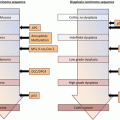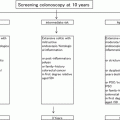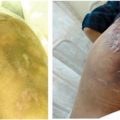Author
Year of publication
Type of study
IBD patients
No. of CAC patients
Incidence or risk ratios
Eaden et al. [19]
2001
Meta-analysis
UC
1,698
10 years, 1.6; 20 years, 8.3; 30 years, 18.4 %
Jess et al. [36]
2012
Meta-analysis
UC
229
10 years, <1 %; 15 years, 0.2–2.0 %; 20 years, 1.1–5.3 %
Lutgens et al. [37]
2013
Meta-analysis
UC and CD
NA
10 years, 1 %; 20 years, 2 %; >20 years, 5 %
Ekbom et al. [45]
1990
Population based
UC
91
5.7 (1958–1984)
Winther et al. [34]
2004
Population-based cohort
UC
124
10 years, 0.4 %; 20 years, 1.1 %; 30 years, 2.1 %
Rutter et al. [35]
2006
Prospective
UC
30
20 years, 2.5 %; 30 years, 7.6 %; 40 years, 10.8 %
Lakatos et al. [20]
2006
Population based
UC
13
10 years, 0.6 %; 20 years, 5.4 %; 30 years, 7.5 %
Söderlund et al. [41]
2009
Population based
UC and CD
188
10 years, 1 %; 20 years, 1.5 %; 30 years, 2.7 %
Jess et al. [42]
2012
Nationwide survey
UC and CD
UC: 268, CD: 70
1.34 (1979–1988), 0.57 (1999–2008)
Manninen et al. [43]
2013
Population based
UC and CD
21
1.83 in IBD, 1.99 in UC, 1.82 in CD
Table 2.2
Incidence of colitis-associated cancer in Crohn’s disease (CD)
Author | Year of publication | Type of study | IBD patients | Risk of CAC | Risk of small-bowel cancer |
|---|---|---|---|---|---|
Jess et al. [18] | 2005 | Meta-analysis | CD | 0.9–2.2 | 3.4–66.7 |
Canavan et al. [38] | 2006 | Meta-analysis | CD | 2.5 | 33.2 |
von Roon et al. [39] | 2007 | Meta-analysis | CD | 2.4 | 28.4 |
Laukoetter et al. [40] | 2011 | Meta-analysis | CD | 0.5 person-years | 0.3 person-years |
Lovasz et al. [44] | 2013 | Population-based cohort | CD | 7.73 | NA |
In studies published in the 1980s to 1990s, the risk for CRC in UC was around 7 % 20 years after UC diagnosis [31] and around 14 % at 25 years [32, 33]. In the early 2000s, the probability of developing CRC in UC was 1.6 % at 10 years, 8.3 % at 20 years, and 18.4 % at 30 years [19]. According to more recent data, the cumulative incidences of CRC in UC are approximately 1.0 % at 10 years, 2.0–5.0 % at 20 years, and 5.0–7.5 % at 30 years [20, 34, 35]. The decreased incidence of CAC in IBD may be because of the improved therapeutic management of colitis, with higher rates of mucosal healing, but definitive clinical and experimental evidence supporting these observations is lacking.
Because chronic inflammation of the large bowel is an important factor in the development of CRC, anti-inflammatory agents have been considered as chemopreventive agents.
2.9.1 Meta-analysis of the Incidence of CRC in UC
The reported incidence varies widely between studies, which reflects the different periods of data collection, different methodologies, and data originating from studies in different countries. The results of the three meta-analyses published in the English-language literature are summarized briefly below.
Eaden et al. [19] accumulated the results of 116 studies comprising 54,478 patients with UC. In this cohort, there were 1,698 cases of CRC. The probability of developing CRC 10 years after UC diagnosis was 1.6 %, rising to 8.3 % after 20 years and 18.4 % after 30 years. The overall prevalence of CAC in UC in that series was 3.7 %, increasing to 5.4 % in patients with pancolitis. The data pointed to an association between the extent of colitis and the increased risk of CAC.
Jess et al. [36] carried out a meta-analysis of eight studies on the basis of strict inclusion and exclusion criteria. During 14 years of follow-up, 1.6 % of the patients in their study were diagnosed with UC-CAC. The pooled standardized incidence ratio (SIR) was 2.4 (range, 1.05–3.1). The cumulative incidences of CRC development were <1.0 % at 10 years, 0.4–2 % at 15 years, and 1.1–5.3 % at 20 years of follow-up. The sex-specific risk ratio was 1.9 in females and 2.6 in males. The age-specific risk ratio was 8.6 in patients 0–39 years of age, 2.1 in those 40–60 years of age, and 1.7 in those 60 years of age and older. Patients with extensive colitis and pancolitis (beyond proctosigmoiditis) had a 4.8-fold higher risk of UC-CAC.
Lutgens et al. [37] reported that the pooled SIR of CRC in IBD patients was 1.7 (range, 1.2–2.2). The cumulative risk of CRC was 1 %, 2 %, and 5 % after 10, 20, and >20 years of disease duration, respectively. The authors concluded that the risk of CRC in IBD patients is significantly higher in patients with longer disease duration, extensive disease, and IBD diagnosed at a young age.
2.9.2 Meta-analysis of the Incidence of CRC in CD
In an earlier meta-analysis, Jess et al. [18] evaluated six population-based studies in which the incidence of intestinal malignancies in CD patients was examined. The overall pooled risk estimates (SIRs) for CRCs in CD ranged from 0.9 to 2.2. The SIR for small-bowel cancer ranged from 3.4 to 66.7. The overall pooled estimate for intestinal malignancies in CD was 27.1. These results showed that CD patients have an overall higher risk of CRC and small-bowel cancer.
Canavan et al. [38] accumulated the results of 13 studies comprising 11,840 patients with CD to examine the incidence of intestinal malignancies in that group. The overall relative risk (RR) of CRC in CD was 2.5 (range, 1.3–4.7). The risk of CRC in CD was shown to be significantly higher than in the general population but not significantly different from that in UC. The cumulative RR for CRC development in CD was 2.9 % at 10 years after CD diagnosis, 5.6 % at 20 years, and 8.3 % at 30 years. However, the authors also found that the overall RR for small-bowel cancer in CD was 33.2 (range, 15.9–60.9). Thus, the risk of small-bowel cancer is much higher in CD patients than in the general population.
Von Roon et al. [39] accumulated the results of 34 studies with a total of 60,122 patients with CD. Compared with the baseline general population, the RRs of CRC and small-bowel cancer were 2.4 (95 % confidence interval, 1.6–4.4) and 28.4 (95 % confidence interval, 14.5–55.7), respectively.
Laukoetter et al. [40] analyzed the results of 20 studies comprising 40,547 patients with CD. The incidence of CD-associated cancer (CDAC) was 0.8/1,000 person-years, meaning that during a 1-year observation period, 0.8 CD patients out of 1,000 developed CDAC. The incidence of CRC and small-bowel carcinoma in CD was 0.5/1,000 and 0.5/1,000 person-years, respectively. The mean age at CRC diagnosis in CD patients was 51.5 years, which is 20 years earlier than in the general population. The mean duration between CD diagnosis and CDAC was 18.3 years.
2.9.3 Incidence of CRC in IBD in a Population-Based Cohort Study
Sderlund et al. [41] assessed cancer occurrence and cancer-related mortality in 7,607 Swedish IBD patients in a population-based cohort study. CRC was detected in 188 IBD patients during 198,227 person-years of follow-up. Compared with the general population, the incidence of CRC in IBD corresponded to an overall twofold higher risk (SIR, 2.3). The overall cumulative incidence of CRC in IBD at 10, 20, and 30 years after IBD diagnosis was 1 %, 1.5 %, and 2.7 %, respectively.
Jess et al. [42] studied CRC risk in a nationwide cohort of 47,374 Danish patients with IBD over a 30-year period. Over the course of the follow-up evaluation, 268 patients with UC (0.5 %) and 70 patients with CD (0.1 %) developed CRC. The overall RR of CRC in UC patients was comparable to that of the general population (RR = 1.1), whereas the RR of CRC in CD patients was slightly lower (0.9) but did not change significantly over time. In UC patients, the overall RR for CRCs decreased from 1.34 between 1979 and 1988 to 0.57 between 1999 and 2008.
Manninen et al. [43] studied the risk of CRC in a nationwide cohort of 1,915 Finnish patients with IBD (1,254 with UC, 550 with CD, and 111 with inflammatory bowel unclassified). CRC was found in 21 patients. The SIR was 1.83 for IBD, 1.99 for UC, and 1.92 for CD.
Lovasz et al. [44] examined the CRC risk in 640 CD patients with colonic involvement and stenosing disease in a population-based cohort from Hungary. CRC was diagnosed in six CD patients during a follow-up of 7,759 person-years. The mean overall CRC incidence rate was 7.73 per 10,000 patient-years.
2.9.4 Incidence of CRC in UC in a Population-Based Cohort Study
Ekbom et al. [45] examined a population-based cohort of 3,117 patients with UC. In 91 patients with UC, there were 92 cases of CRC (2.9 %). Compared with the general population, the RR for CRC was 1.7 for patients with proctitis, 2.8 for those with left-sided colitis, and 14.8 for those with pancolitis. Less extensive colitis at diagnosis was associated with a lower risk of CRC development.
Winther et al. [34] evaluated a population-based cohort of 1,160 patients with UC in Copenhagen County. After a follow-up of up to 36 years, there were 124 malignancies (10.7 %). The cumulative probability of CRC was 0.4 % by 10 years, 1.1 % by 20 years, and 2.1 % by 30 years of disease. The authors concluded that neither the overall cancer risk nor the risk of CAC was increased after a median of 19 years of follow-up. In their analysis of surgical intervention, the overall cumulative probability of colectomy was 21.3 % after 10 years, 27.9 % after 20 years, 29.9 % after 30 years, and 31.1 % after 35 years. This is in contrast to a rate of 9.1–16.4 % in the cohort reported by Eaden et al. [19]. An active surgical approach after medical treatment failure may explain the low rate of CRC development in the former study.
Rutter et al. [35] examined 600 patients who underwent 2,627 colonoscopic surveillance procedures over a 30-year period, during which 74 patients (12.3 %) developed neoplasia, including 30 cases of CRC (5 %). The cumulative incidence of CRC by colitis duration was 2.5 % at 20 years, 7.6 % at 30 years, and 10.8 % at 40 years. During the surveillance program, 89 patients (14.8 % of the study population) underwent colonic surgery.
Lakatos et al. [20] evaluated the relevant epidemiological and clinical data of 723 UC patients in a Hungarian population-based cohort study. CRC was detected in 13 patients (8,564-person-year duration). The cumulative risk of developing CRC after a 10-year duration of colitis was 0.6 %, which increased to 5.4 % at 20 years and 7.5 % at 30 years.
2.10 Risk Factors for CAC
The increased risk of CAC in IBD patients is thought to be due to genetic and acquired factors (Table 2.3), including the duration, extent, and severity of colitis, the presence of post-inflammatory polyps (pseudopolyps), young age at onset of colitis, sex, family history of sporadic CRC, coexistence of primary sclerosing cholangitis and/or colonic strictures, and the presence of colonic dysplasia. Of these, the most important and well-recognized risk factors for CAC are the duration and extent of colitis.
Table 2.3
Risk factors for colitis-associated cancer
Risk factor | Relevant references |
|---|---|
Duration of colitis | |
Extent of colitis | |
Severity of colitis | |
Post-inflammatory polyps | |
Young age at onset of colitis | |
Sex | |
Family history of sporadic colorectal cancer | |
Primary sclerosing cholangitis | |
Colonic stricture | Rutter et al. [47] |
Colonic dysplasia | Lakatos et al. [20] |
2.10.1 Duration of Colitis
The importance of colitis duration as a risk factor for the development of CRC in IBD patients is supported by several studies, including the above-cited studies of Eaden et al. [19] (Sect. 2.9.1), Lakatos et al. [20] (Sect. 2.9.4), and Rutter et al. [35] (Sect. 2.9.4). In the study of Lakatos et al. [20], a longer duration of colitis (10 years) was identified as a risk factor for developing CRC, according to a logistic regression model (odds ratio, 8.3; P = 0.04). Nieminen et al. [46] examined 183 IBD patients with dysplasia or CRC and 368 matched control patients in a case-control study. They concluded that an increasing degree of inflammation and disease duration cumulatively increased the risk of dysplasia in IBD.
2.10.2 Extent of Colitis
Current evidence suggests that the risk of CAC begins to increase after 8–10 years of extensive colitis, defined as left-sided colitis extending from the anal verge to the splenic flexure, and pancolitis (beyond the splenic flexure). By contrast, several studies have shown that there is little or no increased risk of CRC in patients with proctitis or proctosigmoiditis. Chronic colonic inflammation presumably leads to dysplasia and thus eventually to cancer.
The relationship between the extent of colitis and CRC was cited in the abovementioned study of Ekbom et al. [45] (Sect. 2.9.4). In the study of Eaden et al. [19], among UC patients with pancolitis, the cumulative incidence of CRC was 2.1 % at 10 years, 8.5 % at 20 years, and 17.8 % at 30 years disease duration. These data are very similar to the cumulative incidence of CRC in all UC patients, indicating that the development of CRC in UC is associated with pancolitis.
Stay updated, free articles. Join our Telegram channel

Full access? Get Clinical Tree








